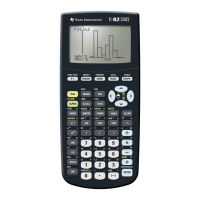gives the Non-real result error. However, the correct result is returned if you include the complex i:
ln(-ℯ^(x))+0
returns
x+*Œ
Note that adding 0i to the original expression does not change it.
(Credit to Kevin Kofler)
[6.53] Implicit derivatives
An implicit derivative results from differentiating an implicit function of the form f(x,y) = 0. Implicit
differentiation is covered in all basic calculus texts, so I will skip the details here, and focus on finding
implicit derivatives with the TI-89/TI-92+.
The most straight-forward method to find the implicit derivative of f(x,y) is to specify y = y(x) in the
expression and use the built-in differentiation function (). For example, to find the implicit derivative of
f
(
x,y
)
= 4 $ x
2
− 6 $ x $ y + 3 $ y
2
use
(4*x^2-6*x*y(x)+3*(y(x))^2,x)
or
(4*x^2-6*x*y+3*y^2,x)|y=y(x)
which both return
(
6 $ y
(
x
)
− 6 $ x
)
$
d
dx
(
y
(
x
))
− 6 $ y
(
x
)
+ 8 $ x
Note that the derivative occurs as a single term, so you can solve for it. First, copy the expression from
the history area, and substitute for the derivative; I use the temporary variable yp:
(6*y(x)-6*x)*(y(x),x)-6*y(x)+8*x|(y(x),x)=yp
which returns
(6*yp-6)*y(x)+(8-6*yp)*x
Now set the expression equal to zero and solve for the derivative:
solve((6*yp-6)*y(x)+(8-6*yp)*x=0,yp)
which returns
yp =
3$y
(
x
)
−4$x
3
$
(
y
(
x
)
−x
)
You can repeat this process to find higher-order derivatives.
If you need to solve many implicit derivatives, particularly of higher orders, it is worthwhile to define a
function. The following routine is a modified version of routines by David Stoutemyer and Don Phillips.
impdifn(ü,x,y,ñ)
Func
Local e,e1,i
If part(ü,0)="=" © Convert equation to expression if necessary
left(ü)-right(ü)→ü
⁻(ü,x)/((ü,y))→e1 © Find first derivative
e1→e
6 - 91

